
The number of Italian food products that have focused on the presence of a PDO or PGI ingredient as a characterizing element is growing. The goal is to differentiate from competitors and gain a premium positioning, through typical foods with a strong evocative appeal and a solid reputation for quality.
The products involved are many. They range from spreadable cream with Cioccolato di Modica PGI to Fanta with Arance Rosse di Sicilia PGI, from Findus vegetable soup with Basilico Genovese PDO, Patata del Fucino PGI, and Cipolla Rossa di Tropea Calabria PGI to the filled pasta with Prosciutto di Parma PDO or Gorgonzola PDO cheese.
Discover the authentic Italian PDO, PGI products on the Italianfood.net platform
The use of protected denominations and Geographical Indications as raw materials for industrial processing is a growing phenomenon. It involves big names of the Italian food industry such as Ferrero, brands belonging to multinationals such as Findus, real giants such as McDonald’s and Coca-Cola, but also small companies of the same territory from which the GI products come from.
Italian processed food by PDO, PGI ingredients content
| First Courses | 52% |
| Condiments | 45% |
| Gelatos | 31% |
| Pizzas | 30% |
| Sweets | 30% |
| Cold Cuts | 27% |
| Frozen Foods | 23% |
| Jams | 20% |
| Beverage | 19% |
| Dairy | 19% |
| Fresh Cut Vegetables | 14% |
| Fruit Juices | 11% |
| Pickles | 11% |
| Cosmetics | 9% |
| Bakery | 9% |
According to the latest research by Fondazione Qualivita, the Italian association that promotes the country’s Geographical Indications, PDOs and PGIs destined for processing have reached a production value of 260 million euros, generating more than one billion euros in turnover (final consumption). The food processing companies that used a certified quality product in 2020 were 1,600, for a total of 4,600 active authorizations and 13,000 issued so far.
After all, faced with a consumer whose taste is on average more evolved and who is attentive to the origin of what he or she brings to the table, food industries using products that bear the now well-known European Community seal is proving to be a winning strategy from several points of view.
CASE HISTORIES
McDonald’s was one of the first to understand the added value of using GIs food products. This is why it launched, more than 10 years ago, its Mcltaly based on Parmigiano Reggiano PDO and, more recently, the My Selection collection signed by Joe Bastianich.
The sandwiches created by the well-known Italian-American restaurateur include many excellent products in the sector, such as Cipolla Rossa di Tropea Calabria PGI, Asiago PDO, Pecorino Toscano PDO, and Balsamic Vinegar of Modena PGI, which are the most iconic samples of this “glocal” union between two culinary worlds that were originally apart.
Qualivita’s analysis also underlined the absence of precise and uniform European legislation regulating the conditions for the use of PDOs and PGIs as ingredients. Not only in the product composition – understood as the minimum quantity of EU-certified food that a product can contain in order for the ingredient to be defined as characterizing – but also in the labeling, presentation, and advertising of food containing PDO and PGI products.
In Italy, on the other hand, there are regulations in charge of recognized protection Consortia and the Ministry of Agriculture.
